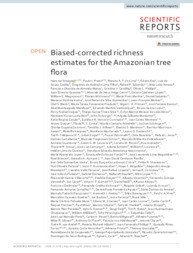Biased-corrected richness estimates for the Amazonian tree flora.
Biased-corrected richness estimates for the Amazonian tree flora.
Autoria: STEEGE, H. ter; PRADO, P. I.; LIMA, R. A. F. de; POS, E.; COELHO, L. de S.; LIMA FILHO, D. de A.; SALOMÃO, R. P.; AMARAL, I. L.; MATOS, F. D. de A.; CASTILHO, C. V. de; PHILLIPS, O. L.; GUEVER, J. E.; CARIM, M. de J. V.; LÓPEZ, D. C.; MAGNUSSON, W. E.; WITTMANN, F.; MARTINS, M. P.; SABATIER, D.; IRUME, M. V.; GUIMARÃES, J. R. da S.; MOLINO, J.-F.; BÁNKI, O. S.; PIEDADE, M. T. F.; PITMAN, N. C. A.; RAMOS, J. F.; MONTEAGUDO MENDOZA, A.; VENTICINQUE, E. M.; LUIZE, B. G.; NÚÑEZ VARGAS, P.; SILVA, T. S. F.; NOVO, E. M. M. de L.; REIS, N. F. C.; TERBORGH, J.; MANZATTO, A. G.; CASULA, K. R.; CORONADO, E. N. H.; MONTERO, J. C.; DUQUE, A.; COSTA, F. R. C.; CASTÑO ARBOLEDA, N.; SCHÖNGART, J.; ZARTMAN, C. E.; KILLEN, T. J.; MARIMON, B. S.; MARIMON-JUNIOR, B. H.; VASQUEZ, R.; MOSTACEDO, B.; DEMARCHI, L. O.; FELDPAUSCH, T. R.; ENGEL, J.; PETRONELLI, P.; BARALOTO, C.; ASSIS, R. L.; SIMON, M. F.; MEDEIROS, M. B. de; QUARESMA, A.; LAURANCE, S. G. W.; RINCÓ, L. M.; ANDRADE, A.; SOUSA, T. R.; CAMARGO, J. L.; SCHIETTI, J.; LAURANCE, W. F.; QUEIROZ, H. L. de; NASCIMENTO, H. E. M.; LOPES, M. A.; FARIAS, E. de S.; MAGALHÃES, J. L. L.; BRIENEN, R.; AYMARD C. G. A.; REVILLA, J. D. C.; VIEIRA, I. C. G.; CINTRA, B. B. L.; STEVENSON, P. R.; FEITOSA, Y. O.; DUIVENVOORDEN, J. F.; MOGOLLÓN, H. F.; ARAUJO-MURAKAMI, A.; FERREIRA, L. V.; LOZADA, J. R.; COMISKEY, J. A.; TOLEDO, J. J. de; DAMASCO, G.; DÁVILA, N.; LOPES, A.; GARCÍA-VILLACORTA, R.; DRAPER, F.; VICENTINI, A.; VALVERDE, F. C.; LLOYD, J.; GOMES, V. H. F.; NEILL, D.; ALONSO, A.; DALLMEIER, F.; SOUZA, F. C. de; GRIBEL, R.; ARROYO, L.; CARVALHO, F. A.; AGUIAR, D. P. P. de; AMARAL, D. D. do; PANSONATO, M. P.; FEELEY, K. J.; BERENGUER, E.; FINE, P. V. A.; GUEDES, M. C.; BARLOW, J.; FERREIRA, J. N.; VILLA, B.; PEÑUELA MORA, M. C.; JIMENEZ, E. M.; MONTERO, J. C.; CERÓN, C.; THOMAS, R.; MASS, P.; SILVEIRA, M.; HENKEL, T. W.; STROPP, J.; PAREDES, M. R.; DEXTER, K. G.; DALY, D.; BAKER, T. R.; HUAMANTUPA-CHUQUIMACO, I.; MILLIKEN, W.; PENNINGTON, T.; TELLO, J. S.; PENA, J. L. M.; PERES, C. A.; KLITGAARD, B.; FUENTES, A.; SILMAN, M. R.; Di FIORE, A.; HILDEBRAND, P. von; CHAVE, J.; ANDEL, T. R. van; HILÁRIO, R. R.; PHILLIPS, J. F.; RIVAS-TORRES, G.; NORONHA, J. C.; PRIETO, A.; GONZALES, T.; CARPANEDO, R. de S.; GONZALES, G. P. G.; ZGÓMEZ, R. Z.; RODRIGUES, D. de J.; ZENT, E. L.; RUSCHEL, A. R.; VOS, V. A.; FONTY, E.; JUNQUEIRA, A. B.; DOZ, H. P. D.; HOFFMAN, B.; ZENT, S.; BARBOSA, E. M.; MALHI, Y.; BONATES, L. C. de M.; MIRANDA, I. P. de A.; SILVA, N.; BARBOSA, F. R.; VELA, C. I. A.; PINTO, L. F. M.; RUDAS, A.; ALBUQUERQUE, B. W.; UMAÑA, M. N.; CARRERO MÁRQUEZ, Y. A.; HEIJDEN, G. van der; YOUNG, K. R.; TIRADO, M.; CORREA, D. F.; SIERRA, R.; COSTA, J. B. P.; ROCHA, M.; TORRE, E. V.; WANG, O.; OLIVEIRA, A. A.; KALAMANDEEN, M.; VRIESENDORP, C.; RAMIREZ-ANGULO, H.; HOLMGREN, M.; NASCIMENTO, M. T.; GALBRAITH, G.; FLORES, B. M.; SCUDELLER, V. V.; CANO, A.; REATEGUI, M. A. A.; MESONES, I.; BAIDER, C.; MENDOZA, C.; ZAGT, R.; GIRALDO, L. E. U.; FERREIRA, C.; VILLARROEL, D.; LINARES-PALOMINO, R.; FARFAN-RIOS, W.; FARFAN-RIOS, W.; CASAS, L. F.; CÁRDENAS, S.; BALSLEV, H.; TORRES-LEZAMA, A.; ALEXIADES, M. N.; GARCIA-CABRERA, K.; GAMARRA, L. V.; SANDOVAL, E. H. V.; RAMIREZ AREVALO, F.; HERNANDEZ, L.; SAMPAIO, A. F.; PANSINI, S.; PALACIOS CUENCA, W.; OLIVEIRA, E. A. de; PAULETTO, D.; LEVESLEY, A.; MELGAÇO, K.; PICKAVANCE, G.
Resumo: Amazonian forests are extraordinarily diverse, but the estimated species richness is very much debated. Here, we apply an ensemble of parametric estimators and a novel technique that includes conspecific spatial aggregation to an extended database of forest plots with up-to-date taxonomy. We show that the species abundance distribution of Amazonia is best approximated by a logseries with aggregated individuals, where aggregation increases with rarity. By averaging several methods to estimate total richness, we confirm that over 15,000 tree species are expected to occur in Amazonia. We also show that using ten times the number of plots would result in an increase to just ~50% of those 15,000 estimated species. To get a more complete sample of all tree species, rigorous field campaigns may be needed but the number of trees in Amazonia will remain an estimate for years to come.
Ano de publicação: 2020
Tipo de publicação: Artigo de periódico
Unidade: Embrapa Roraima
Palavras-chave: Amazonia, Ecologia Florestal, Espécie, Floresta Tropical, Árvore
Observações
1 - Por padrão são exibidas publicações dos últimos 20 anos. Para encontrar publicações mais antigas, configure o filtro ano de publicação, colocando o ano a partir do qual você deseja encontrar publicações. O filtro está na coluna da esquerda na busca acima.
2 - Para ler algumas publicações da Embrapa (apenas as que estão em formato ePub), é necessário ter, no celular ou computador, um desses softwares gratuitos. Sistemas Android: Google Play Livros; IOS: iBooks; Windows e Linux: software Calibre.
Acesse outras publicações
Acesse a Base de Dados da Pesquisa Agropecuária (BDPA) para consultar o acervo completo das bibliotecas da Embrapa.

